The Effect of Different Socket Morphologies of a Maxillary Central Incisor on the Accuracy of Immediate Implants Placed With Freehand or Guided Surgery—An In Vitro Study
Abstract
Objective
To evaluate the effect of socket morphology of a maxillary central incisor on accuracy of single implants placed with freehand or static guided surgery in simulated extraction sockets.
Materials and Methods
An anatomic central incisor was digitally designed and subtracted from the model to create socket morphology 1 (SM1), socket morphology 2 (SM2), and socket morphology 3 (SM3) simulating a central, retroclined, and proclined tooth. 90 implants were placed with freehand (FH); pilot guided (PG) and fully guided (FG) protocols in 30 models of SM1, SM2 and SM3 each. Implant accuracy was measured for vertical deviation (MVP), maximum horizontal deviation at implant platform (MHP) and apex (MHA), buccolingual (BLP, BLA), mesiodistal (MDP, MDA), and global angular deviation (GAD) deviations.
Results
The effect of interaction between SM and protocol was significant only on MVP (p = 0.03) and GAD (p = 0.000). Individual effect of SM was significant for all variables except mesiodistal deviation. Significant difference was observed among all groups for MHA and BLP, between SM1 and SM2 for all variables except mesiodistal deviation, between SM2 and SM3 for MHP and SM1 and SM3 for BLA (p < 0.05). Implant accuracy was almost similar with FG or PG protocol (p > 0.05) except for MVP (FG vs. PG = 0.01). Buccolingual inaccuracies of implants were higher than mesiodistal deviations.
Conclusions
Vertical, horizontal, and angular deviations were highest in SM2 and least in group SM1. Within each socket, higher implant accuracy was observed with guided protocols than freehand placement. Results of this in vitro study should be interpreted with caution as the outcome may be different in real clinical settings.


 求助内容:
求助内容: 应助结果提醒方式:
应助结果提醒方式:


